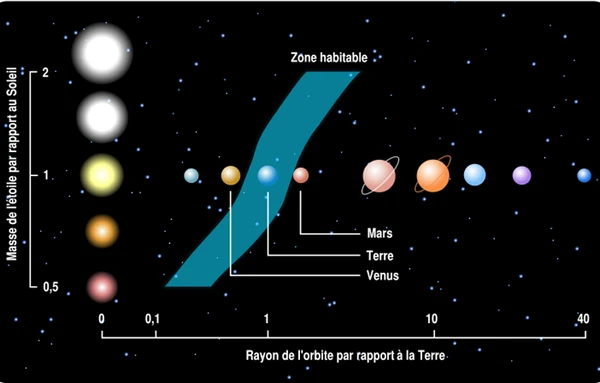
In astronomy, the CHZ is the region around a star where thermal conditions allow liquid water to exist on a planet's surface. The concept of the habitable zone was developed by astronomer Su-Shu Huang (1915-1977) in 1959 and later popularized by Michael Hart (1932-) in the 1970s. The position of this zone mainly depends on the luminosity of the central star. For a star like the Sun, the habitable zone extends approximately from 0.95 to 1.67 AU (1 AU = Earth-Sun distance).
The inner limit corresponds to the threshold where the greenhouse effect triggers runaway ocean evaporation. The outer limit occurs when CO2 condenses and even maximum radiative forcing can no longer prevent freezing. The distance \(d\) of the habitable zone can be estimated by the formula: \(d = \sqrt{\frac{L_{\ast}}{L_{\odot}}}\) where \(L_{\ast}\) is the star's luminosity and \(L_{\odot}\) is the solar luminosity.
Stars do not have constant luminosity. Their luminosity increases over time, expanding or shifting the habitable zone. In 1 billion years, Earth may leave the Sun's inner habitable zone. Planets that are habitable today may not be tomorrow, and vice versa; some icy planets may enter a future habitable zone.
N.B.:
Generally, for a solar-type star, luminosity increases by ≈ +10% every ~1 Gyr. At its formation (age ≈ 0.05 Gyr), the Sun's luminosity was only about 70% of its current luminosity.
Some scientists extend the concept of the habitable zone to moons of giant planets, such as Europa (around Jupiter) or Enceladus (around Saturn), where subsurface oceans could harbor life thanks to tidal heating.
The concept of the habitable zone applies not only to stars but also to galaxies. This is called the GHZ (Galactic Habitable Zone). It is the region of a galaxy where conditions are most favorable for the emergence and sustainability of complex life.
In our Galaxy, the galactic habitable zone is generally estimated as a ring located between about 7 and 9 kiloparsecs from the center (23,000 to 30,000 light-years). Fortunately, the Solar System is located at ≈ 8 kpc from the center, right in this supposedly optimal zone.
Since 1995, over 5,000 exoplanets have been detected. Among them, a fraction lies in the habitable zone of their star. The most emblematic example is Proxima Centauri b, located 4.2 light-years away, which receives stellar flux compatible with the presence of liquid water. However, actual habitability depends on many factors: atmosphere, magnetic field, stellar activity.
| Star Type | Star Temperature (Teff) | Habitable Zone Distance | Stability Duration | Example |
|---|---|---|---|---|
| Red Dwarf (M) | ≈ 2,400 – 3,700 K | ≈ 0.1 – 0.3 AU | ~ 100 Gyr | Proxima Centauri, Gliese 581 |
| Solar-type Star (G) | ≈ 5,300 – 6,000 K | ≈ 0.9 – 1.5 AU | ~ 10 Gyr | Sun, Tau Ceti |
| Subgiant (F) | ≈ 6,000 – 7,500 K | ≈ 2 – 4 AU | ~ 3 Gyr | Procyon A, Canopus |
| Massive Star (O-B) | ≈ 10,000 – 30,000 K | > 10 AU | < 100 Myr | Sirius, Rigel |